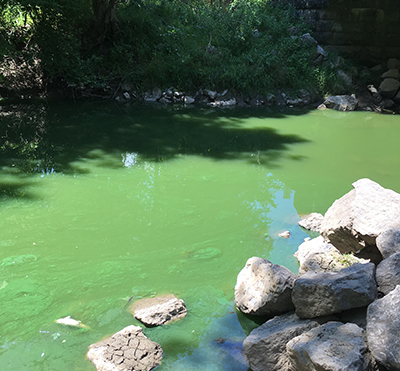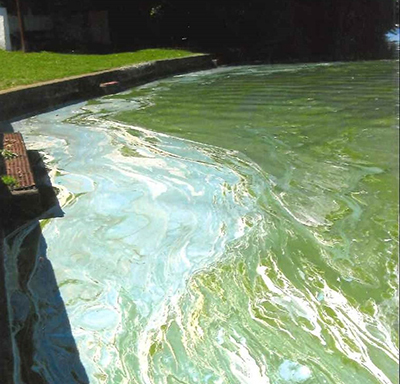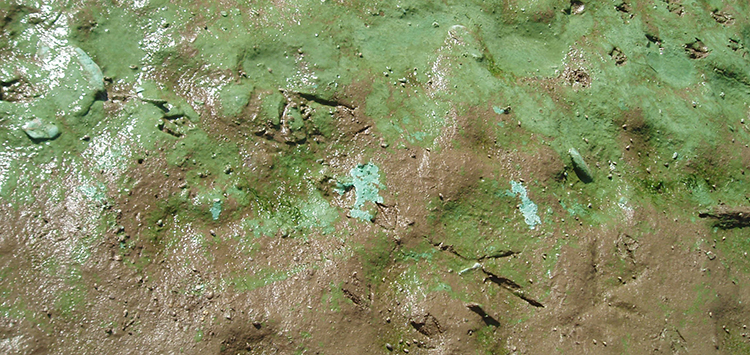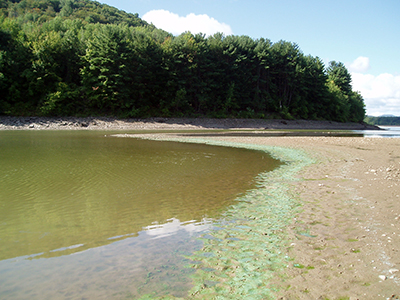 Harmful algal blooms (HABS) pop up every year in Pennsylvania as water temperatures rise. The typical season for algal blooms ranges from the middle of June to late August but HABs can occur during other times of the year if conditions are right. Despite the frequency of HABs in the commonwealth’s waters, there still seems to be a mystery surrounding them.
Harmful algal blooms (HABS) pop up every year in Pennsylvania as water temperatures rise. The typical season for algal blooms ranges from the middle of June to late August but HABs can occur during other times of the year if conditions are right. Despite the frequency of HABs in the commonwealth’s waters, there still seems to be a mystery surrounding them.
What is a Harmful Algal Bloom?
Harmful Algal Blooms (HABs) occur when Cyanobacteria, commonly known as blue-green algae, grow in large, dense populations. HABs have been observed worldwide including in Lake Erie and other Pennsylvania waters and can occur almost anywhere: lakes, ponds, stormwater retention basins, rivers, streams, or reservoirs.
What are the characteristics of a HAB?
An algal bloom can look like foam, scum, mats, or paint floating on the surface of water. Some blooms are not visible at the water surface. Water bodies with an ongoing bloom may look blue, green, brown, yellow, orange, or red. When organisms in a bloom die and decompose, they can release unpleasant odors (like the smell of rotting plants).
What causes HABS?
 Blooms generally occur where there are high levels of nutrients present, together with the occurrence of warm, sunny, calm conditions. However, human activity often can trigger or accelerate algal blooms. Natural sources of nutrients such as phosphorus or nitrogen compounds can be supplemented by a variety of human activities. For example, in rural areas, agricultural runoff from fields can wash fertilizers into the water. In urban areas, nutrient sources can include treated wastewaters from septic systems and sewage treatment plants, and urban stormwater runoff that carries nonpoint-source pollutants such as lawn fertilizers.
Blooms generally occur where there are high levels of nutrients present, together with the occurrence of warm, sunny, calm conditions. However, human activity often can trigger or accelerate algal blooms. Natural sources of nutrients such as phosphorus or nitrogen compounds can be supplemented by a variety of human activities. For example, in rural areas, agricultural runoff from fields can wash fertilizers into the water. In urban areas, nutrient sources can include treated wastewaters from septic systems and sewage treatment plants, and urban stormwater runoff that carries nonpoint-source pollutants such as lawn fertilizers.
Are HABS always toxic?
Algae are a diverse group of organisms that carry out photosynthesis. These organisms are crucial for a “healthy” freshwater environment and are the base of the aquatic food web where most other aquatic organisms depend on them, whether it be directly or indirectly. A healthy waterbody generally contains a variety of different types of algae present at any one time. The concern occurs when this diversity disappears and instead the waterbody becomes dominated by blue-green algae. While they can grow to very high densities (sometimes forming surface scums), they are not necessarily dangerous (i.e. toxic). It is when these blue-green algae start producing cyanotoxins that they become a toxic algal bloom. It’s important to note that some blooms never become toxic. These toxins are invisible to the human eye and impossible to know whether they are present without analyzing them for these chemical compounds.

How are HABS harmful to humans?
People can get sick when they come in contact with water or food contaminated with algal toxins by:
- Participating in recreational activities such as swimming, kayaking, fishing, or wading through water.
- Breathing in contaminated tiny water droplets or mist from recreational activities or wind-blown sea spray.
- Drinking contaminated water.
- Eating contaminated seafood (fish or shellfish).
Are there particular symptoms people display?
Symptoms can vary depending on the type of exposure, amount and type of toxin and how long the person was exposed to the contaminated water or bloom. Topical symptoms include rashes, blisters, hives, and eye and nose irritations. If swallowed, potential symptoms could include diarrhea, vomiting, abdominal pain, numbness of lips, tingling in fingers and toes, dizziness, and headache.
Why are dogs at risk from algal blooms?
 Dogs are much more susceptible than humans to cyanobacterial poisoning. When toxins are present, dogs can be exposed to toxins by drinking the water, by eating washed-up mats or scum of toxic cyanobacteria, and by having skin contact with water. Dogs are often attracted to algal scum odors. After leaving the water, dogs can also be poisoned by grooming their fur and paws. Signs of toxic poising, such as excessive salvation, weakness, staggered walking, difficulty breathing, or convulsions can occur within 30 minutes to a few hours after exposure, depending on the size of the dog, the type of toxin, the toxin concentration and how much toxin the dog has ingested. In severe cases, dogs can show signs of cyanobacterial poisoning within a few minutes and can die within an hour of toxin exposure.
Dogs are much more susceptible than humans to cyanobacterial poisoning. When toxins are present, dogs can be exposed to toxins by drinking the water, by eating washed-up mats or scum of toxic cyanobacteria, and by having skin contact with water. Dogs are often attracted to algal scum odors. After leaving the water, dogs can also be poisoned by grooming their fur and paws. Signs of toxic poising, such as excessive salvation, weakness, staggered walking, difficulty breathing, or convulsions can occur within 30 minutes to a few hours after exposure, depending on the size of the dog, the type of toxin, the toxin concentration and how much toxin the dog has ingested. In severe cases, dogs can show signs of cyanobacterial poisoning within a few minutes and can die within an hour of toxin exposure.
How will you know if there is a HAB?
Look for posted HAB advisory signs or ask a park manager about any recent HABs because colorless toxins can remain in the water after visible blooms fade. Confirmation of HABs can only be made by testing for their toxins with a field or laboratory test.
What should you do if you see a HAB?
- Stay out of the water.
- Don’t let children or pets play in HAB debris on shore.
- After swimming/wading in water, even with no visible HABs, rinse off with fresh water as soon as possible.
- Never swallow untreated surface water. It may contain algal toxins or bacteria, parasites, or viruses that could cause illness if consumed.
- Do not let pets lick or eat HAB material from their fur.
- Don’t drink/cook with suspected water. In-home treatments like boiling, chlorine bleach, or water filtration units offer no protection from HAB toxins!
- See a doctor if you or your children might be ill from HAB toxins. Contact your veterinarian for sick pets.
If you would like to report a potential HAB, or have any questions, please
contact your local DEP regional office.